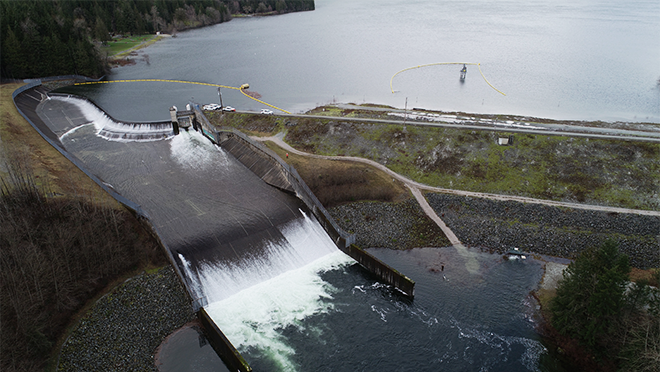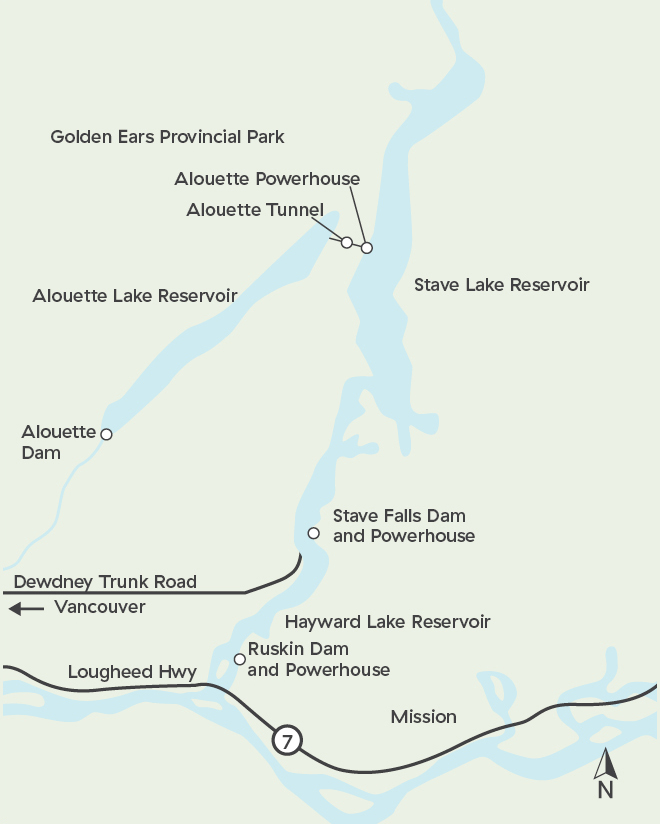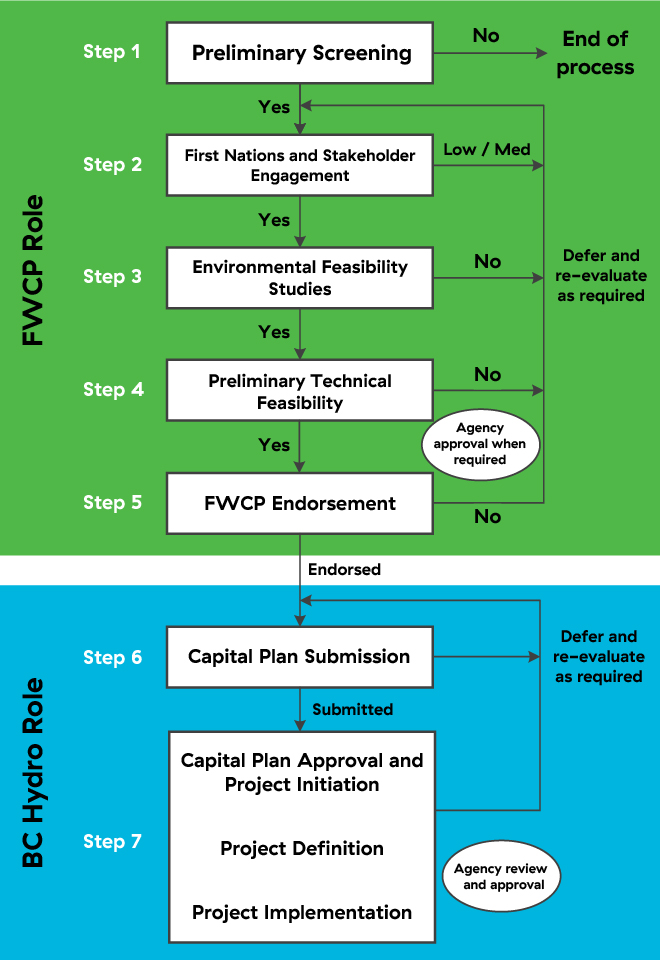Alouette system

System overview
The Alouette, Stave Falls, and Ruskin hydroelectric system is comprised of three generation facilities:
- Alouette (Alouette Generating Station, Alouette Lake Reservoir, Alouette Dam);
- Stave Falls (Stave Falls Generating Station, Stave Lake Reservoir, Stave Falls and Blind Slough Dams); and
- Ruskin (Ruskin Generating Station, Hayward Lake Reservoir, Ruskin Dam).
The Alouette system includes:
- Alouette Dam
- Alouette Lake Reservoir
- Power Intake and Tunnel, from Alouette Lake Reservoir to Alouette Generating Station or into Stave Lake Reservoir
- Alouette Generating Station

Alouette Dam
- Located on the Alouette River at the natural outlet of Alouette Lake.
- Impounds the Alouette River forming the Alouette Lake Reservoir over the original lake.
- Downstream of the dam, South Alouette River flows through Maple Ridge and Pitt Meadows before discharging into Pitt River.
Alouette Lake Reservoir
- Lies in a narrow valley and extends northeast for about 17 km from the dam.
- Water can be released from the reservoir to South Alouette River via water release facilities at the dam or to Stave Lake Reservoir through a tunnel between the reservoirs.
Tunnel
- Located on the east shore of Alouette Lake Reservoir near the north end of the reservoir.
- Water entering the tunnel exits to Stave Lake Reservoir through either the generator at Alouette Generating Station or a bypass adit located at the Stave Lake Reservoir end of the tunnel.
Alouette Generating Station
- 9 MW, located on the west side of Stave Lake Reservoir.
- Due to its poor equipment conditions and worker safety limitations, the station has been out of service since 2010.
- Water entering Stave Lake Reservoir is used by the Stave Falls and Ruskin generating stations.
Area affected
The Alouette Project is part of the Alouette-Stave-Ruskin hydroelectric system located north of Maple Ridge and Mission. Alouette Dam is located at the south end of the reservoir. Downstream of the dam, Alouette River flows through the municipalities of Maple Ridge and Pitt Meadows before discharging into Pitt River. The Maple Ridge area is more intensively developed than the Pitt Meadows area. Water moves from Alouette Lake Reservoir to Stave Lake Reservoir through a tunnel at the northeastern end of the reservoir.
This majority of the area around Alouette Lake Reservoir is a fairly remote area of the Metro Vancouver Regional District and the land through which the power tunnel passes and Stave Lake Reservoir are located in the Fraser Valley Regional District.
BC Hydro works to upgrade and maintain existing assets like the facilities at Alouette so that our customers continue to receive reliable and clean electricity. We have a number of projects of various sizes and complexity currently underway at Alouette including seismic upgrades at the tunnel between Alouette Lake Reservoir and Stave Lake Reservoir, upgrades to the outlets that move water from Alouette Lake Reservoir to Alouette River and service upgrades at Alouette Generating Station. Information on these projects is provided at the links below.
Alouette Headworks and Surge Tower Upgrade (Tunnel Project)
Alouette Upgrade Station Service Project (Station Service Project)
Water Use Plans (WUPs) were developed for Alouette and Stave to provide a better balance between competing water uses. The WUPs were implemented through Orders issued by the Comptroller of Water Rights (CWR) which identified water management constraints as well as monitoring studies to be undertaken to determine if objectives were being met.
We’re now undertaking a Water Use Plan Order Review (WUPOR) as the final step in implementing B.C.’s Water Use Plan Guidelines. Through the WUPOR we’ll determine whether the ordered constraints are achieving the environmental and social objectives identified in each facility’s WUP Order.
The Alouette-Stave-Ruskin WUPOR began in May 2019 and is being undertaken on an integrated, system-wide basis. We expect that the outcome of the WUPOR will be a single Order for the Alouette-Stave-Ruskin System.
Get more information the Alouette and Stave Water Use Plan Order Reviews
- Alouette Water Use Plan Order Review and Water Use Plan, including the terms of reference, monitoring studies and annual reports.
- The Stave Water Use Plan Order Review and Water Use Plan, including the terms of reference, monitoring studies and annual reports.
In September 2018 we applied to renew one of three water licences at the Alouette facility. Since then we’ve conducted a technical review of the application and will be submitting the findings of this review to the Comptroller of Water Rights in fall 2021. The Comptroller will then review the renewal application, undertake a formal referral process, and make a decision on the renewal application.
At Alouette, we currently use a combination of trap and truck and spring releases from the dam to provide sockeye upstream and downstream fish passage, respectively.
We’re committed to evaluating an expansion of trap and truck as well as other fish passage options through the Fish Passage Decision Framework in support of a salmon restoration program. The framework is a seven-step process that outlines the advancement, evaluation, implementation, and funding of fish passage restoration projects at our facilities. It was developed in 2008 by BC Hydro, DFO and the Government of B.C. to ensure proposed fish passage is both biologically and technically feasible. To implement the framework, we’re working with the Alouette River Salmon Restoration Program Committee which consists of representatives from Indigenous Nations, the Government of B.C., BC Hydro, Alouette River Management Society, and technical support.

Why we're doing it
The development of some of our dams in coastal rivers resulted in a blockage to migratory fish. Fish passage facilitates migration around barriers, such as dams, to restore access to historical habitats and increase fish production.
Although the Fish & Wildlife Compensation Program (FWCP) funds many fisheries projects, funding fish passage programs was not originally considered as part of the FWCP. In 2008, the Fish Passage Decision Framework was developed to support the FWCP in evaluating proposals for fish passage programs.
The Alouette River Salmon Restoration Program (ARSRP) Committee is working through Steps 3 and 4 of the Fish Passage Decision Framework.
In 2017, the Alouette River Salmon Restoration Program (ARSRP) Committee identified smolt production from the Alouette Reservoir as a key factor limiting salmon restoration to the Alouette watershed, and subsequently proposed the implementation of a sockeye hatchery to assess its feasibility as a restoration option. In 2020, the ARSRP and Katzie First Nation identified smolt outmigration and entrainment as priorities for assessment prior to consideration of a hatchery. As part of its updated study plan [PDF, 52 KB], ARSRP is implementing two study components to investigate the impacts of BC Hydro’s Alouette operations on smolt outmigration success, both at the dam and the diversion tunnel between Alouette and Stave Lake reservoirs:
Smolt Outmigration at Alouette Dam
As part of the Alouette Water Use Plan, minimum flows of 3 cubic meters per second (m3/s) are released from the spillway between April 15 and June 14 to facilitate Sockeye smolt outmigration. Annual monitoring conducted since 2005 to estimate the number of Sockeye smolts outmigrating from Alouette Lake Reservoir have confirmed the spillway releases have resulted in an average of approximately 15,000 smolts outmigrating down the South Alouette river per year.
In spring 2021, BC Hydro implemented an experimental operation to investigate whether increased spillway flows would result in increased outmigration. Monitoring was undertaken in the South Alouette River from April 15 to June 2, after the smolt captures had ceased, to determine the effects of the increased flows on smolt outmigration. Study finding are now being compiled and assessed.
Entrainment of Smolts at Alouette Tunnel
Fish entrainment is the process whereby fish upstream of flow management structures are swept downstream as a function of operations and/or fish behaviour. The impacts of the Alouette-Stave Diversion Tunnel (ALU tunnel) operations, passing water from Alouette Lake Reservoir to Stave Lake Reservoir, on smolt outmigration success is currently unknown. To estimate the proportion of smolts entrained at the tunnel relative to the number of smolts out migrating down the Alouette Dam spillway to the South Alouette River, the ARSRP is implementing hydroacoustic monitoring of the ALU tunnel from spring 2021 through summer 2022.
Biological feasibility studies are funded by the Fish & Wildlife Compensation Program (FWCP) and can take several years to complete. Learn more about FWCP and their studies.
Additional information on the Fish Passage Decision Framework
FWCP is a partnership between BC Hydro, the Province of B.C., Fisheries and Oceans Canada, First Nations, and public stakeholders to conserve and enhance fish and wildlife impacted by BC Hydro dam footprints.
Since 1999 over $1.8M has been spent on 50 projects in the Alouette River Watershed. This includes $825,000 for 19 projects related to Sockeye restoration in Alouette River.
The RAP was established in 2008 to assess and manage impacts to protected archaeological sites in the active erosion zones of 26 reservoirs and to ensure operations comply with the Heritage Conservation Act. The Alouette RAP was developed in partnership with Katzie First Nation in 2009 and final reporting is underway.
Additional information about the Alouette RAP [PDF, 360 KB]
Contact
projects@bchydro.com
604 623 4472
Toll free: 1 866 647 3334